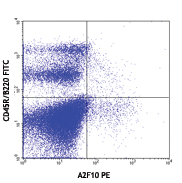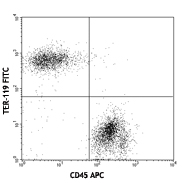- Clone
- 2B8 (See other available formats)
- Regulatory Status
- RUO
- Other Names
- c-KIT, Stem Cell Factor Receptor (SCFR)
- Isotype
- Rat IgG2b, κ
- Ave. Rating
- Submit a Review
- Product Citations
- publications

-

C57BL/6 mouse splenocytes were stained with anti-mouse CD11b (clone M1/70) FITC and anti-mouse CD117 (c-Kit) (clone 2B8) PE/Cyanine7 (left) or rat IgG2b, κ PE/Cyanine7 isotype control (right).
| Cat # | Size | Price | Quantity Check Availability | Save | ||
|---|---|---|---|---|---|---|
| 105813 | 25 µg | 70€ | ||||
| 105814 | 100 µg | 169€ | ||||
CD117 is a 145 kD immunoglobulin superfamily member also known as c-Kit and stem cell factor receptor (SCFR). It is a transmembrane tyrosine-kinase receptor that binds the c-Kit ligand (also known as steel factor, stem cell factor, and mast cell growth factor). CD117 is expressed on hematopoietic stem cells (including multipotent hematopoietic stem cells, progenitors committed to myeloid and/or erythroid lineages, and T and B cell precursors), mast cells, and acute myeloid leukemia (AML) cells. CD117 interaction with its ligand is critical for the development of hematopoietic stem cells.
Product DetailsProduct Details
- Reactivity
- Mouse
- Antibody Type
- Monoclonal
- Host Species
- Rat
- Immunogen
- Mouse bone marrow mast cells
- Formulation
- Phosphate-buffered solution, pH 7.2, containing 0.09% sodium azide.
- Preparation
- The antibody was purified by affinity chromatography, and conjugated with PE/Cyanine7 under optimal conditions.
- Concentration
- 0.2 mg/mL
- Storage & Handling
- The antibody solution should be stored undiluted between 2°C and 8°C, and protected from prolonged exposure to light. Do not freeze.
- Application
-
FC - Quality tested
- Recommended Usage
-
Each lot of this antibody is quality control tested by immunofluorescent staining with flow cytometric analysis. For flow cytometric staining, the suggested use of this reagent is ≤ 0.25 µg per million cells in 100 µL volume. It is recommended that the reagent be titrated for optimal performance for each application.
- Excitation Laser
-
Blue Laser (488 nm)
Green Laser (532 nm)/Yellow-Green Laser (561 nm)
- Application Notes
-
Additional reported applications (for the relevant formats) include: immunoprecipitation1, immunohistochemistry of acetone fixed frozen sections2, and spatial biology (IBEX)5,6. The 2B8 antibody does not block c-Kit activity.
- Additional Product Notes
-
BioLegend is in the process of converting the name PE/Cy7 to PE/Cyanine7. The dye molecule remains the same, so you should expect the same quality and performance from our PE/Cyanine7 products. Please contact Technical Service if you have any questions.
- Application References
-
- Ikuta K, et al. 1992. P. Natl. Acad. Sci. USA 89:1502. (FC)
- Podd BS, et al. 2006. J. Immunol. 176:6532. PubMed (IHC)
- Bachelet I, et al. 2008. J. Immunol. 180:6064. PubMed (FC)
- Charles N, et al. 2010. Nat. Med. 16:701. PubMed (FC)
- Radtke AJ, et al. 2020. Proc Natl Acad Sci U S A. 117:33455-65. (SB) PubMed
- Radtke AJ, et al. 2022. Nat Protoc. 17:378-401. (SB) PubMed
- Product Citations
- RRID
-
AB_313222 (BioLegend Cat. No. 105813)
AB_313223 (BioLegend Cat. No. 105814)
Antigen Details
- Structure
- Ig superfamily, 145 kD
- Distribution
-
Hematopoietic stem cells, AML, mast cells
- Function
- Growth factor receptor, tyrosine kinase
- Ligand/Receptor
- Stem Cell Factor (SCF)
- Cell Type
- Embryonic Stem Cells, Hematopoietic stem and progenitors, Leukemia, Mast cells, Mesenchymal Stem Cells
- Biology Area
- Immunology, Stem Cells
- Molecular Family
- CD Molecules
- Antigen References
-
1. Barclay A, et al. 1997. The Leukocyte Antigen FactsBook Academic Press.
2. Galli SJ, et al. 1994. Adv. Immunol. 55:1.
3. Ikuta K, et al. 1992. Annu. Rev. Immunol. 10:759.
4. Besmer P, et al. 1986. Nature 320:415.
5. Witte ON. 1990. Cell 63:5. - Gene ID
- 16590 View all products for this Gene ID
- UniProt
- View information about CD117 on UniProt.org
Customers Also Purchased


Compare Data Across All Formats
This data display is provided for general comparisons between formats.
Your actual data may vary due to variations in samples, target cells, instruments and their settings, staining conditions, and other factors.
If you need assistance with selecting the best format contact our expert technical support team.
 Login / Register
Login / Register 















Follow Us